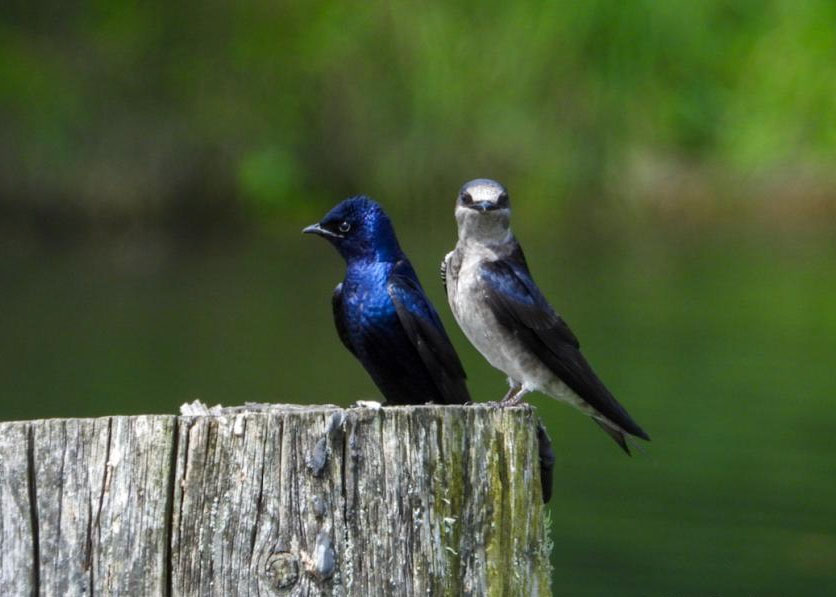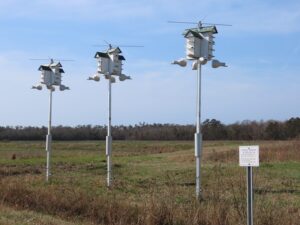At this time of year, a unique birdsong rings out over the parking lot at Mass Audubon’s Wellfleet Bay Wildlife Sanctuary. It’s jumbled and metallic, almost bubbly, and unlike any other sound on the Outer Cape. If you walk over to the field behind the visitors center, you’ll find the source of this song.
There, large, dark swallows fly overhead like tiny fighter jets. The males’ plumage looks black, but when the light strikes the feathers, they reveal an iridescent bluish-purple sheen. The females, no less beautiful, have traces of the male’s shining plumage above but combine it with a soft gray-brown mottling beneath. They swarm around the sanctuary’s visitors center, chattering to each other and flying in and out of the gourd-shaped white structures where they nest.
These are purple martins, and they might be my favorite birds on the Outer Cape.
Maybe it’s their songs. But more, I think, it’s their charisma that charms me. I’m fascinated by these birds’ relationship with people.

Purple martins are cavity nesters, meaning they nest in holes in trees or structures. In the American West, they nest in natural nest cavities, usually ones that were drilled by woodpeckers and then abandoned. Once upon a time, they did the same in the East, but not anymore: every known purple martin nest east of the Rocky Mountains is in a human-made birdhouse.
Martin birdhouses take many forms, from standard rectangular boxes to multi-nest “condos” on tall aluminum poles. Often their houses are made to look like hollowed-out gourds, which were the earliest known human-made martin nests. Mark Catesby’s 1729 book Natural History, the first published account of North America’s wildlife, describes Southern settlers hanging hollowed-out gourds to attract martins as early as 1712.
In all likelihood, white settlers borrowed this technique from indigenous people like the Choctaw and Chickasaw. Black settlers also hung gourds for martins along the banks of the Mississippi River, a practice that dates to at least the early 19th century, according to early ornithologist Alexander Wilson.
These birdhouses were not just for their keepers’ birdwatching enjoyment, though. Martins subsist entirely on flying insects, particularly flying ants, so some people believe that putting up martin nests near their crops protects them from infestation. And martins also help farmers by aggressively defending their own nests from crows and blackbirds, which helps keep nearby crops safe from these birds, too.
The practice of hanging martin nests grew in popularity through the 19th century, and, in 1883, the first commercially manufactured martin houses were brought to market. These were elaborate structures, often consisting of multiple stories of nesting holes, complete with broad porches and ornate windows, positioned high in the air on poles. One wonders whether the martins appreciated the Gilded-Age architecture.

Just as the martin house business was booming, invaders arrived from Europe: European starlings. These birds were introduced to a variety of places around North America as part of the acclimatization movement in which white people introduced European species to the continent to “enrich” the local flora and fauna. Instead, these introduced species tended to either die out quickly or become incredibly destructive.
Starlings fall into the latter category. Like martins, they are cavity nesters, but they tend to be more aggressive and will outcompete martins for nest sites. Even if a martin has already established a nest, starlings will simply kill its occupants, destroy the eggs, and begin constructing their own nest in that same space. House sparrows, which were introduced in North America around the same time, are similarly violent.
By 1900, martins had been kicked out of nearly every natural nest in eastern North America by these invaders. If they were to survive, they needed manmade nests, with human “landlords” who could destroy the nests of starlings and house sparrows before they took over.
More than 100 years later, martins still haven’t recovered from the arrival of house sparrows and starlings. They also likely face other threats, from pesticides killing their insect prey to climate change-driven extreme weather. But thanks to human-built nests, they can hold on in places like Wellfleet Bay, where the white multi-nest “condos” atop rows of aluminum poles are swarmed by martins all summer long.
You’re unlikely to find them anywhere else out here — purple martins tend to be a rare sight away from their nest boxes. But here, at the sanctuary, it’s a joy watching these birds’ antics. They fly so quickly, long wings held steady, and can turn on a dime to chase after an insect. They sing constantly, filling the air with their boisterous and varied songs. They squabble and fight and mate all out in the open.
We love to romanticize the idea of nature untouched by humans and imagine that there exists some place in the American wilderness free from the influence of people. But such a place doesn’t exist. Even ignoring pollution, climate change, and invasive species, people, and not just colonizers but indigenous people, have been changing the landscape of North America for thousands of years.
In the end, this “unnatural” human influence is not entirely negative. The same society that introduced starlings and house sparrows to North America also gave purple martins a new way to nest. It’s irrational, yes, but our society is not known for its rational approach to environmentalism. So, I’m grateful to the people who give purple martins a place to make their home on the Outer Cape and give us the chance to know them.



